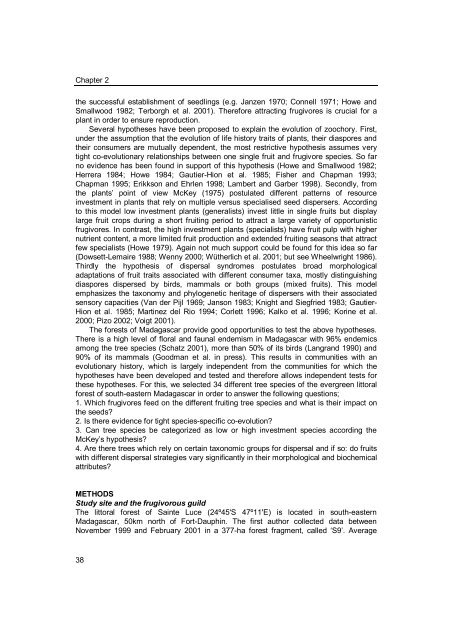Fruit-frugivore interactions in a Malagasy littoral forest - Universiteit ...
Fruit-frugivore interactions in a Malagasy littoral forest - Universiteit ...
Fruit-frugivore interactions in a Malagasy littoral forest - Universiteit ...
Create successful ePaper yourself
Turn your PDF publications into a flip-book with our unique Google optimized e-Paper software.
Chapter 2<br />
the successful establishment of seedl<strong>in</strong>gs (e.g. Janzen 1970; Connell 1971; Howe and<br />
Smallwood 1982; Terborgh et al. 2001). Therefore attract<strong>in</strong>g <strong>frugivore</strong>s is crucial for a<br />
plant <strong>in</strong> order to ensure reproduction.<br />
Several hypotheses have been proposed to expla<strong>in</strong> the evolution of zoochory. First,<br />
under the assumption that the evolution of life history traits of plants, their diaspores and<br />
their consumers are mutually dependent, the most restrictive hypothesis assumes very<br />
tight co-evolutionary relationships between one s<strong>in</strong>gle fruit and <strong>frugivore</strong> species. So far<br />
no evidence has been found <strong>in</strong> support of this hypothesis (Howe and Smallwood 1982;<br />
Herrera 1984; Howe 1984; Gautier-Hion et al. 1985; Fisher and Chapman 1993;<br />
Chapman 1995; Erikkson and Ehrlen 1998; Lambert and Garber 1998). Secondly, from<br />
the plants’ po<strong>in</strong>t of view McKey (1975) postulated different patterns of resource<br />
<strong>in</strong>vestment <strong>in</strong> plants that rely on multiple versus specialised seed dispersers. Accord<strong>in</strong>g<br />
to this model low <strong>in</strong>vestment plants (generalists) <strong>in</strong>vest little <strong>in</strong> s<strong>in</strong>gle fruits but display<br />
large fruit crops dur<strong>in</strong>g a short fruit<strong>in</strong>g period to attract a large variety of opportunistic<br />
<strong>frugivore</strong>s. In contrast, the high <strong>in</strong>vestment plants (specialists) have fruit pulp with higher<br />
nutrient content, a more limited fruit production and extended fruit<strong>in</strong>g seasons that attract<br />
few specialists (Howe 1979). Aga<strong>in</strong> not much support could be found for this idea so far<br />
(Dowsett-Lemaire 1988; Wenny 2000; Wütherlich et al. 2001; but see Wheelwright 1986).<br />
Thirdly the hypothesis of dispersal syndromes postulates broad morphological<br />
adaptations of fruit traits associated with different consumer taxa, mostly dist<strong>in</strong>guish<strong>in</strong>g<br />
diaspores dispersed by birds, mammals or both groups (mixed fruits). This model<br />
emphasizes the taxonomy and phylogenetic heritage of dispersers with their associated<br />
sensory capacities (Van der Pijl 1969; Janson 1983; Knight and Siegfried 1983; Gautier-<br />
Hion et al. 1985; Mart<strong>in</strong>ez del Rio 1994; Corlett 1996; Kalko et al. 1996; Kor<strong>in</strong>e et al.<br />
2000; Pizo 2002; Voigt 2001).<br />
The <strong>forest</strong>s of Madagascar provide good opportunities to test the above hypotheses.<br />
There is a high level of floral and faunal endemism <strong>in</strong> Madagascar with 96% endemics<br />
among the tree species (Schatz 2001), more than 50% of its birds (Langrand 1990) and<br />
90% of its mammals (Goodman et al. <strong>in</strong> press). This results <strong>in</strong> communities with an<br />
evolutionary history, which is largely <strong>in</strong>dependent from the communities for which the<br />
hypotheses have been developed and tested and therefore allows <strong>in</strong>dependent tests for<br />
these hypotheses. For this, we selected 34 different tree species of the evergreen <strong>littoral</strong><br />
<strong>forest</strong> of south-eastern Madagascar <strong>in</strong> order to answer the follow<strong>in</strong>g questions;<br />
1. Which <strong>frugivore</strong>s feed on the different fruit<strong>in</strong>g tree species and what is their impact on<br />
the seeds?<br />
2. Is there evidence for tight species-specific co-evolution?<br />
3. Can tree species be categorized as low or high <strong>in</strong>vestment species accord<strong>in</strong>g the<br />
McKey’s hypothesis?<br />
4. Are there trees which rely on certa<strong>in</strong> taxonomic groups for dispersal and if so: do fruits<br />
with different dispersal strategies vary significantly <strong>in</strong> their morphological and biochemical<br />
attributes?<br />
METHODS<br />
Study site and the frugivorous guild<br />
The <strong>littoral</strong> <strong>forest</strong> of Sa<strong>in</strong>te Luce (24º45'S 47º11'E) is located <strong>in</strong> south-eastern<br />
Madagascar, 50km north of Fort-Dauph<strong>in</strong>. The first author collected data between<br />
November 1999 and February 2001 <strong>in</strong> a 377-ha <strong>forest</strong> fragment, called ‘S9’. Average<br />
38

















